Study site
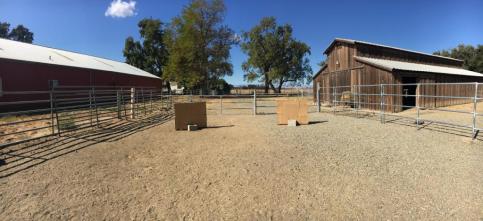
The experiments were carried out at the T.S. Glide Ranch in Davis, California, USA - a charitable foundation to protect animals, wildlife, agriculture and the environment of Yolo County. The ranch comprises several housing facilities and barns, as well as pasture and agricultural fields. An outdoors test arena was implemented in the area, so that it was as isolated as possible, but not isolated enough to hinder the animal’s displacement. Being in the vicinity of a working farm, the arena was not detached from potential environmental stimuli for the animals.
California is characterized by a Mediterranean climate where precipitation occurs mostly in the winter and cold temperatures are rare. Vegetation in Mediterranean-type climates is composed by sparse woodlands, grasses and shrubs (Seager et al., 2019). The climate in Davis follows the latter description and the region is defined by flat lands that have frequently been converted into agricultural use.
The study was conducted between September and February, therefore covering two very different three months periods – long, warm, and dry days from September to November and shorter, cold and often rainy days from December to the end of February.
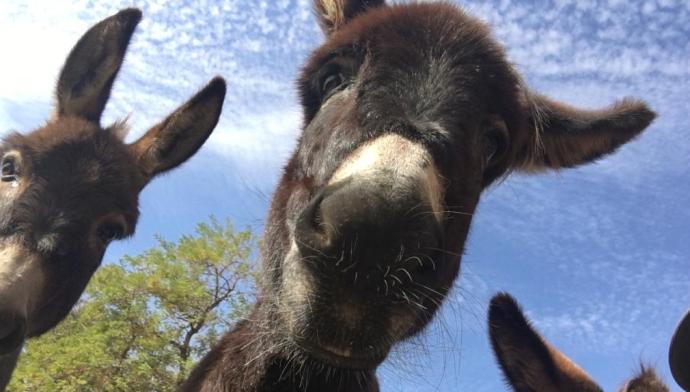
Animals
The study subjects (n=8 females, 4 males), ranging in age from one to twelve years were part of a group of eighteen rescued miniature donkeys, currently being kept as pets in shared pastures, with other donkeys, goats and cows. The animals’ daily activities included almost no human interaction besides feeding, which happened twice a day (early morning and evening), occasional visits by the veterinarians and monthly blood collection for research purposes. The donkeys had not undergone any prior systematic training previous to this study. The group was rescued from two different locations, both private owners that could no longer care for them, moved to a temporary location, and finally brought to the Glide. Some individuals were rescued as adults, others as foals, and two were later born at the ranch.
The donkeys went through approximately three weeks of training, or long enough to show increased cooperation with the researchers and reduced fear levels associated with the test arena and material. During this period, each individual was brought to the test arena for approximately half an hour per day, led at a walk with a halter and leadline, and allowed to interact, investigate and become familiar with the test apparatus.
Data collection
Weather and Training
Wind, temperature and humidity were recorded for each test.
Food was used as a motivator to encourage donkeys to complete the tasks in all experiments. A food mix of apples, carrots, dry treats and grain was used in order to attend to various individual preferences.
Training sessions included first time interactions and familiarization with the food bucket, which finally led to a choice of a smaller, pan-shaped test bucket that reduced fear related responses associated with the loss of peripheral vision while reaching for the food. Contrary to what has been done in previous studies, the food bucket did not have a lid during the tests. The reason for this being that it not only increased fear as it did not decrease latency to find the food or influence the individuals’ choices, during the pilot studies.
There were always two experimenters and one donkey present during experimental trials. Training and habituation sessions often included more than one donkey in the test arena, to promote social buffering and social enhancement towards exploration of new objects.
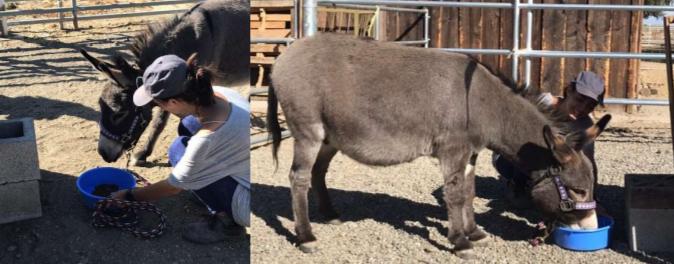
Personality
An adaptation of a previously validated questionnaire (Navas et al., 2012) was completed by ten people including three caretakers, two people that were in occasional contact to the donkeys and five experimenters that had worked with the animals for five weeks. The questionnaire was composed of a total of nineteen ordinal questions concerning specific behavioral qualities such as Concentration, Training potential, Excitability, and Vigilance, for example, which were rated from 1 to 10. To each question followed a description of the behavior, which was defined again at the two extremes of the scale.
Memory and Spatial Cognition
To investigate short-term memory and spatial cognition, a test was adapted from a study conducted by McLean (2004). Each trial started with the individual at location A, it was walked around both sides (experimenter was always on the left of the animal) – the side with no food was always shown first – and allowed to eat from the bucket, which should have been previously hidden behind one of the walls (locations B or C) (Fig.1). The donkey was then guided back to location A and released to explore the arena. A trial was considered successful when the donkey first chose to explore the side of the arena where the food bucket was hidden (registered when the animal’s head was over the D mark), unsuccessful when the donkey first chose to explore the side of the arena opposite to where the food bucket was hidden (registered when the animal’s head was over the D mark) and canceled when, within the first 30 seconds, it did not cross the D mark (Fig. 1).
Throughout a set of ten Familiarization trials (successful or unsuccessful), locations C and D were used alternately to place the food, in a way that the same donkey should not be tested twice with the same location. For these trials, the donkeys were released immediately after being walked around both sides of the arena and brought back to location A (Fig. 1). During this period, the animals were rested and tested later if they happened to have three canceled trials.
The following group of trials (IR, Immediate release phase) was composed by four sets of ten trials, in which the individuals were released immediately after being walked around both sides of the arena and brought back to location A (Fig.1). Locations B and C were used to hide the food in a random order, guaranteeing that each donkey was tested twenty times in each one, and not more than two consecutive times in the same. All donkeys were not tested for at least twelve hours between each set. The individual’s performance was evaluated for this testing phase, in order to identify which donkeys were able to memorize where the food was located. The context of the trials did not allow for the animals to be released immediately after they obtained knowledge of the food location, therefore forcing them to retain that information for thirty seconds, even during IR trials. Donkeys that succeeded (first choosing to explore the side of the arena where the food bucket was hidden) in more than 75% of the trials were qualified to move on to the next test 10 phase (Binomial test, p < 0,05).
Finally, six individuals went through four sets of ten trials, in which they were released thirty seconds after being walked around both sides of the arena and brought back to location A (DR, Delayed release phase) (Fig.1). Otherwise the test procedure remained the same as for the preceding trials.
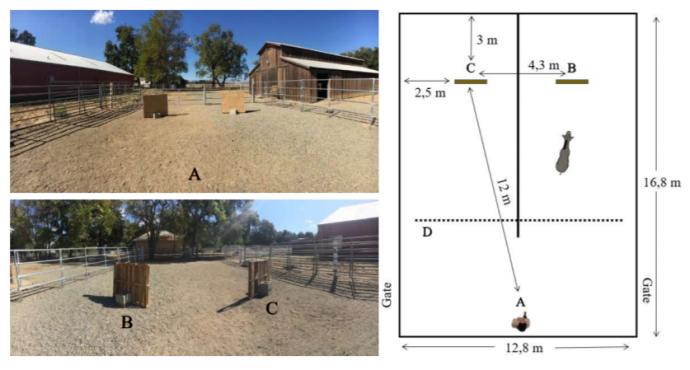
Judgement bias
Following these trials, the donkeys were tested for judgement bias, following a protocol adapted from Freymond et al. (2014).
During a discrimination phase the animals learned to distinguish between a positive and a negative stimulus, in this case a black bucket full of food and a white empty one. This phase included an undefined number of sets, depending on how long it took each individual to learn the distinction, each composed of five positive and five negative trials. Positive trials were characterized by having a bucket full of food on one side of the arena (sides changed between donkeys, with half the group being tested with the positive trials on the left and half on the right), while negative trials had an empty bucket on the opposite side (locations A+ or A−, Fig. 2); there was always just one bucket at a time inside the test arena.
The 11 individuals were brought in to point A (Fig. 2) when a bucket was already positioned on location + or −. They were then released and allowed to explore and, in the case of positive trials, to feed. Latency was measured and registered as the time spent between the donkey’s release at B and the moment when its throat latch was less than one meter away from the bucket. If, after three minutes, the donkey had not reached the bucket, the handler should guide it to the goal and reveal the bucket’s content. Trials were considered finished after three minutes or when the individual’s throat latch was less than one meter away from the goal. After each trial, while the handler brought the donkey back to the start (location A), another experimenter swapped the buckets so that the set up was correct for the following trial. Each set was composed of three positive and three negative trials, randomly ordered in a way that no more than two of the same trials followed each other (i.e. + + − − + −, + + − + − −, − + + − − +, + − − + + −, − − + + − +, − + − − + +) and the animals rested for at least twelve hours between sets.
Donkeys were considered fit to move on to the treatment phase when the latency to reach the positive goal was significantly shorter than the latency to reach the negative goal (MannWhitney test, p < 0,05). The treatment phase exposed the animals to three new buckets of different colors: dark grey, aligned and to the right of the black bucket’s location (+A); medium grey, aligned and at an intermediate position between the black and the white bucket’s location (An); light grey, aligned and to the left of the white bucket’s position (−A) (Fig. 2). These were presented to the test subjects individually, always empty and in random order, across two sets of seven trials (+ − A+ + An – A−; − + A− − An + A+). Individual exposure to this phase was limited to two sets, in order to avoid learning. The remaining steps of the experimental procedure were the same as used for the discrimination learning phase.
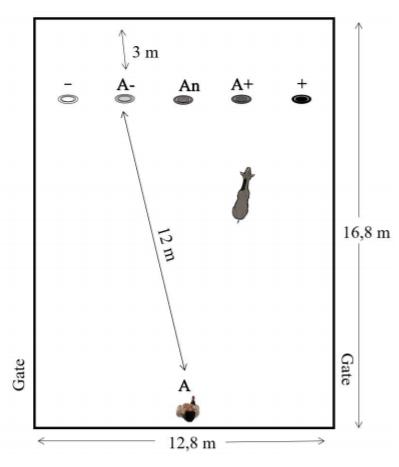
U task
Lastly, eleven donkeys were tested with a modified U-task (Baragli et al., 2011), to further explore spatial cognition. A U-shaped barrier was designed, with three different levels of asymmetry (Fig. 3), two to three experimenters were present. Before the trials began, all donkeys went through a habituation phase and were allowed to explore the test arena for twenty minutes or until a successful detour to reach the food within three attempts. The test was set up during this time of habituation (feed bucket with rope, barriers 1, 2 and 3 – Fig. 3).
For the trials, a test subject was walked in by the handler to A, a bucket with food attached to a rope was previously placed at A and, immediately after the donkey had eaten from it, it the bucket was removed by a second experimenter to B. At this point the donkey could no longer reach the bucket but could still see it (as previously proven to increase difficulty to this task). Individuals were then released and allowed to explore while the handler walked away and stood behind the imaginary line C (Fig. 3). After it successfully detoured the barrier and reached the bucket, the donkey was allowed to eat and then walked back to B for the next trial. The handler stood alternately on the left or right of the animals while walking them, in a way that each animal was walked on the right for half of the trials, and on the left for the remaining ones, in order to avoid influencing side choice during detour behavior. 2
This task was divided in three phases: D0 (barrier 1 – Fig. 3), composed by ten trials of five minutes each or until successful detour (donkey’s throat hatch less than one meter away from the bucket); D1 (barriers 1 and 2 – Fig. 3), composed by ten trials of five minutes each or until successful detour, considering that barrier 2 should be placed on the right for five trials and on the left for the remaining five, following a randomly defined order that did not allow for the barrier to be on the same side for more than two consecutive trials (LRLRRLRRLL); D2 (barriers 1, 2 and 3 – Fig. 3), composed by two sets of ten trials of five minutes each or until successful detour, considering that barriers 2 and 3 should be placed, together, on the right for five trials and on the left for the remaining five, following randomly defined orders that did not allow for the barrier to be on the same side for more than two consecutive trials (LRRLRRLLRL, LRRLLRRLLR). Both the side chosen for the detour and the latency to reach the bucket, from the moment of release at A, were registered. Contrary to previous set ups for this task, the second experimenter was not hidden behind a wall, as this was thought to increase fear levels in the animals during the pilot tests, and eye contact with the experimenter did not seem to influence their performance.
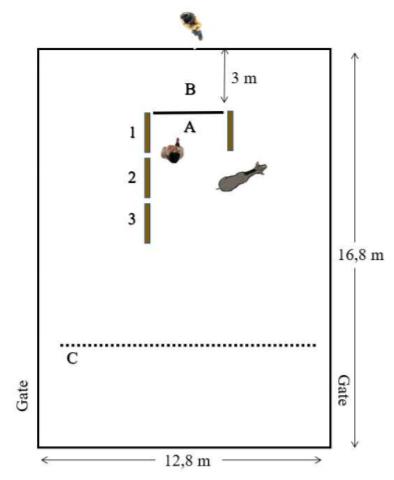
Data analysis
Intraclass correlation coefficient analysis was performed to confirm intra observer reliability between observers that answered the personality questionnaire. For each individual, an average was calculated of the scores given by all the observers in each question. This data was then analyzed using Correlation analysis, in order to cluster the questions into groups that represented broader personality factors. The scores of the correlated questions were then averaged to calculate a score for each factor.
Donkeys that completed IR, first choosing to explore the side of the arena where the food bucket was hidden in more than 75% of the Memory test trials, were qualified to move on to the next test phase (Binomial test, p < 0,05). Success rates were calculated for each Memory test (IR and DR trials), for each donkey, by dividing the number of successful trials by the total number of trials.
Data from the judgement bias tests was reduced to an adjusted latency to approach the ambiguous stimulus (An), for each donkey. The latter was calculated considering the individual’s latencies to approach the positive and negative locations, as follows:

Donkeys were considered fit to move on to the treatment phase when the latency to reach the positive goal was significantly shorter than the latency to reach the negative goal (MannWhitney test, p < 0,05). Standard mean latencies were calculated for the detours in D0, D1 and D2 trials, for each donkey. Side preferences for the same detours were investigated for each individual and at a group level with Binomial tests (p < 0,05).
Correlation analysis was conducted with all the previously mentioned variables: D0, D1 and D2 latencies, IR and DR success rates, Personality scores (Spearman correlation, p<0,05). To assess the effect of weather (Humidity, Wind and Temperature) and time of day (Morning, Afternoon) in the tests’ results, Spearman correlations (p<0,05) and Mann Whitney tests (p<0,05) were. Further analysis was run to investigate correlations with the individual's life history (Kruskal-Wallis, p<0,05) and housing situation (Mann Whitney, p<0,05).
Responsible for this page:
Director of undergraduate studies Biology
Last updated:
05/15/20
